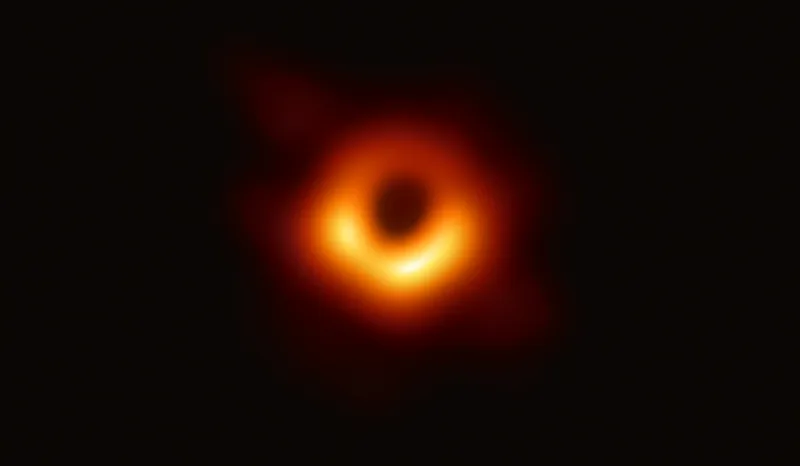Three Scientists Awarded the Nobel Prize in Physics for Breakthrough Black Hole Discoveries
These Nobel laureates helped discover and describe the mysterious cosmic voids in our universe
:focal(1635x1012:1636x1013)/https://tf-cmsv2-smithsonianmag-media.s3.amazonaws.com/filer/f5/4d/f54d4558-e49e-4f62-b1b4-0f8233de2759/10-6_portrait.jpg)
Black holes are cosmic phenomena that never fail to capture the world’s attention and curiosity. Millions of these galactic beasts are peppered throughout the universe, and their gravitational force is so strong that not even light can escape. This morning, the Royal Swedish Academy of Sciences awarded the Nobel Prize in Physics to three scientists for their research that illuminated details of black holes’ existence and function in the universe.
Roger Penrose, a cosmologist and professor emeritus at the University of Oxford in England, received half of the award for demonstrating that black holes exist—an idea that even Albert Einstein himself was skeptical of. The other half of the award was jointly awarded to Reinhard Genzel, the director of the Max Planck Institute for Extraterrestrial Physics in Germany, and Andrea Ghez, an astronomer professor at the University of California in Los Angeles, for discovering a supermassive black hole at the center of the Milky Way. Ghez is the fourth woman to ever receive a Nobel Prize in physics.
“The discoveries of this year’s Laureates have broken new ground in the study of compact and supermassive objects. But these exotic objects still pose many questions that beg for answers and motivate future research,” says David Haviland, chair of the Nobel Committee for Physics, in a press release.
In 1905, Einstein outlined his theory of special relativity, which established that the laws of physics apply throughout the universe, the speed of light is constant and nothing travels fasters than light. A decade later, Einstein presented an added explanation for acceleration to the mix through his theory of general relativity, which indicates that massive objects can distort space-time through their gravitational pull. The theory implied the existence of black holes, objects so massive that their gravitational pull consumes all nearby matter into an inescapable void. But the suggestion was theoretical and even Einstein had his doubts.
But in 1965, ten years after Einstein’s death, Penrose calculated that when too much mass occupies too small a space, it would collapse, thus proving the existence of black holes. Further, he showed that if an object passes the black hole’s outermost boundary, or “event horizon,” it will not be able to escape without traveling faster than the speed of light, which is impossible, according to the special theory of relativity. Running contrary to Einstein’s theory, however, Penrose found that the law of physics do not apply inside a black hole and, in fact, time and space “switch roles,” report Dennis Overbye and Derrick Bryson Taylor for the New York Times.

“Prior to this groundbreaking work, most physicists thought that black holes were merely mathematical curiosities which appear in general relativity but that they would not exist in reality,” Sabine Hossenfelder, a theoretical physicist at the Frankfurt Institute for Advanced Studies in Germany, tells Lee Billings for Scientific American. “The story of the discovery of black holes demonstrates vividly how powerful pure mathematics can be in the quest to understand nature.”
Penrose used math to study black holes, but Genzel and Ghez approached the phenomena with astronomical observations. Working separately with independent teams, the two researchers had a “legendary competition over the years, which has kept the field moving,” Heino Falcke, an Event Horizon Telescope member and astronomer at Radboud University in the Netherlands, tells the news staff at Science.
In the 1990s, Genzel and Ghez were studying stars 26,000 light-years away when they observed stars swirling around a mysterious, invisible force. To see through the whirlpool of stars, the two teams used the world’s largest telescopes and their own pioneering technologies to gaze through the space dust. They took infrared photos and created time lapses to monitor how the stars moved around this enigmatic force over time. In 2002, they sharpened their images and came to the same outstanding conclusion: a supermassive black hole lurks at the center of our galaxy, Robert Irion reported for Smithsonian magazine in 2008. In the years after their breakthrough, Genzel and Ghez have worked to describe black holes and unveil their complexities.
“All of these breakthrough techniques bring us closer than we have ever come to the edge of the unknown, offering novel ways to study the most mysterious objects in the cosmos and to test our most fundamental theories,” Shep Doeleman, project director for the Event Horizon Telescope and astronomer with the Harvard-Smithsonian Center for Astrophysics, tells Scientific American. “The results of the past several years have allowed us to ask questions we could never have formulated before, but more importantly they allow us to dream big. The work celebrated today by the Nobel Prizes is transformative, and the future for black holes, as they say, is bright!”
/https://tf-cmsv2-smithsonianmag-media.s3.amazonaws.com/accounts/headshot/rasha.png)
/https://tf-cmsv2-smithsonianmag-media.s3.amazonaws.com/accounts/headshot/rasha.png)